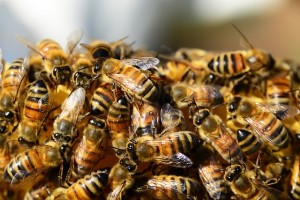(Click here for a audio version of this blog)
There is a lot of interesting research on bees being conducted at the Royal Holloway University of London. Previously, they determined that a commonly used pesticide inhibited the ovaries in bumblebee queens and more recently they have looked into the impacts of some new pesticides on bees and have also evaluated how bumblebees living in cities differ from bumblebees living in the country!
Their research on the impacts of the pesticide sulfoxaflor was published in Nature on August 15, 2018. Sulfoxaflor is a member of the Sulfoximine class of pesticides. Sulfoximines are being considered as replacements for the very commonly used neonicotinoid pesticides that have been shown to have very negative impacts on bees and other pollinating insects. Several neonicotinoids have been banned from use on agricultural fields by the European Union. Neonicotinoids have been shown to inhibit ovarian development in bumblebees (that was the Royal Holloway University study!), to interfere with the ability of honeybees to fly (and, thus, gather nectar and pollen), to reduce the winter survival rates in honeybees, to decrease the reproductive rates in bumblebees, and to make honeybee sperm less active (see Signs of Summer 4, June 26, 2018, Signs of Summer 11, July 7, 2017, and Signs of Fall 9, November 3, 2016).
In this most recent pesticide study, captured bumblebees were fed a sugar solution containing 5 parts per billion of sulfoxaflor (a dosage estimated to be the exposure dosage in a sulfoxaflor-treated field) for two weeks. Those treated bumblebees and a similarly handled control group not exposed to the pesticide were then released back into their habitats. Later in the season the colonies were recovered and reevaluated. The bumblebees exposed to sulfoxaflor produced no new queens during the study period while 12% of the control bumblebees did produce queens during this time frame. The treated bumblebees also had a reduced number of worker bees compared to controls. The researchers stressed that although the bumblebee colonies “survived” the sulfoxaflor treatment, they were significantly stressed and reduced because of it.
The “city bumblebee” vs. “country bumblebee” study was published in the Proceedings of the Royal Society B (June 27, 2018). Two hundred queen bumblebees were collected in a large park in Surrey, U.K. From these queens 40 bumblebee colonies were raised in the lab. These colonies were then placed in urban and rural habitats in and around London. Over several months, the research team visited each colony once a week and made observations and took measurements indicative of the health of each colony. The team found that the bumblebees in the more urban locations had fewer parasites, more offspring, a greater mass of accumulated food (pollen and nectar) in their colonial tube, and that the individuals in the city habitats lived significantly longer. The “city” bumblebees, then, on the basis of these multiple variables were much healthier than the “country” bumblebees.
There were a number of speculations as to why city environments might be healthier for bumblebees. These included an observed decrease in brood parasitism in the city bumblebees. Possibly this occurred because of the scent disruption by all of the odors of the city which made it much harder for brood parasites to find the bumblebees. Also there was an increased diversity and abundance of nectar rich flowers in the gardens of the city which may have provided the bumblebees with a more robust supply of food. There was also less pesticide use in the city environments which may have removed that important stress from the city bumblebees.
This study reminds me of the Michigan study that found bumblebees thriving in the city of Detroit compared to both smaller city environments and rural environments (see Signs of Winter 4, December 28, 2017). The abundance of suitable sites for soil burrows in the patchwork, abandoned lot urban landscape of Detroit was thought to be one of the main features that made the city more conducive to bumblebees than less urban locations.
And, finally, a team headed up by researchers at Penn State University (which also included a number of other universities and research institutions from the United States, India, Ukraine, Panama, and Kenya) have developed a new technique to rapidly and accurately evaluate a bee’s viral microbiome. This technique isolates viral DNA and RNA from a specimen bee and matches it to known viral sequences. The research group applied this technique to extractions from twelve bee species collected from nine countries around the world.
Bee viruses are a very important component in the stress matrix that can lead to Colony Collapse Disorder (C.C.D.), and most of the research on bee viruses have centered on the evaluation of the viruses in honeybees in light of this possible C.C.D. connection. Previous research has described 24 different viruses in honeybees. Some of these viruses seem to cause no harm to the bees while others can cause the death of individual bees or contribute to C.D.C.
The team found the suggestion of 127 viral sequences in their wide range of bee species. Of these total sequences seven were identified as common, previously described bee viruses, and twenty-seven were determined to be new bee viruses! Use of this viral assay technique should greatly expand our knowledge of the viruses that affect a very wide range of bee species!
Wow! Two weeks of bee information! “Industrial bees,” the impacts of proposed pesticides on bees, “city” bumblebees vs. “country” bumblebees, and new ways to study bee viruses! I also just saw on my local NPR station’s Newswire that beekeeping is being classified as a “cool” behavior by young people in Philadelphia! Craft beers, fusion foods, new music and bees! It’s all good!




I have also noticed that city bees seem to do better than country bees. In Aliquippa for instance there is very little widespread pesticide use and lots of weeds. I think just those 2 factors alone explain a lot.